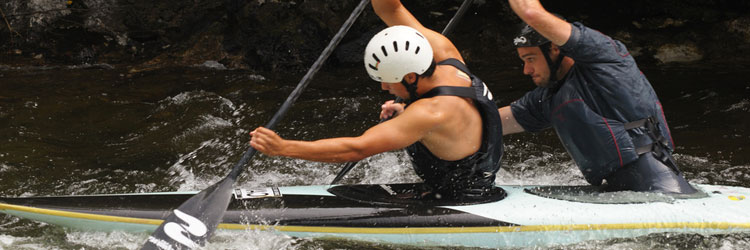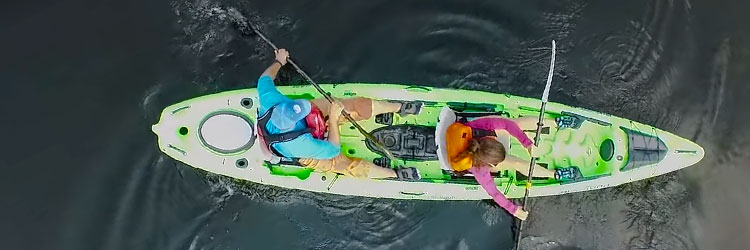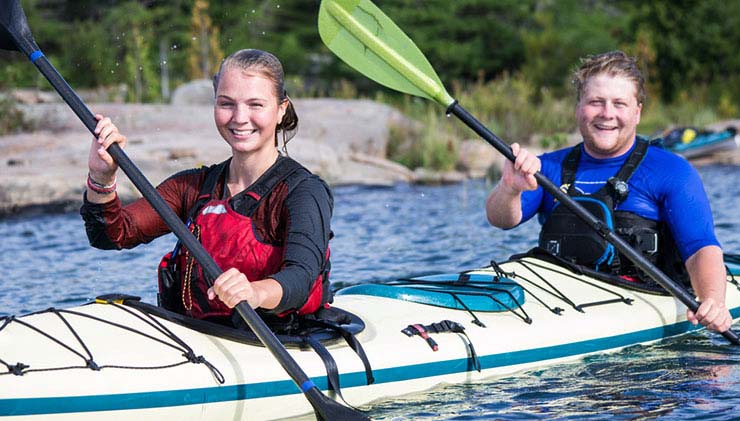For those who love some bonding time with their kids, friends, parents, sweethearts or even their dog, knowing how to paddle a tandem kayak is the way to go. You don’t have to worry about paddling alone in a kayak ever again. Tandem kayaking is a great way to get in the water with your loved one or even introduce new paddlers to this amazing activity.
The tandem kayak is wider than the single one and provides more room for the two of you. The other person does not need to paddle along and this saves an extra muscle just in case.
Although learning the rules of paddling isn’t as detailed as the ones you have to follow while choosing a fast, strong and stable tandem kayak, you still have to undergo a significant learning curve.
In this article, we will discuss everything you need to know about tandem kayaking. Read on and find more on how to tandem kayak.
Table of Contents
Understand Tandem Kayaking
Kayaks have been in existence for thousands of years. We all know that the single paddled kayak is the most common. But due to the difficulty beginners encountered, there was a need to invent something better. That’s when a tandem kayak came up.
A tandem is something that contains two things arranged one before the other. To understand paddling techniques for a tandem kayak, imagine the kayak has 2 sit-in places, one in front and the other right at the back. Tandem Kayaks or canoes can be an excellent options for two people to enjoy kayaking in the same vessel. It is easy to paddle it and always recommended that the inexperienced sit in the steering front.
But sitting position will also be determined with weight, height, practicality, preference and many more. Though it may be hard to communicate with the other person, it is still the best way to take a trip together and as a team.
How to Paddle a Tandem Kayak?
So, what does it take when paddling a tandem kayak? Well, nothing much. It doesn’t need two to paddle a tandem kayak. That’s why it is best for teaching beginners to kayak and also for taking your kids too.
But if you need to paddle together, then unison comes in. You need to talk to each other so as to avoid clashing paddles. All the paddles need to go in the same direction and at the same time. So the person at the front is the one that controls the rhythm. Let us discuss the factors to look at on how to paddle tandem kayaks. In this article, I’ve provided six suggestions to help you become versed in the sports.
#1 Choose a partner
#2 Choose the right kayak and paddle
#3 Abide by the safety matters
#4 Pick up a good position
#5 Start kayaking
#6 Learn the strokes
1. Choose Your Partner
The person you choose for a tandem kayaking will determine your pace and a lot more. If you are going with a kid or a novice, let them sit at the front. They will be the one who determines the pace and direction of the kayak. But for you at the back, you will direct them on what to do.
No matter which partner you choose, make sure that one knows to paddle a tandem more or a little than the other. It is much better to have a partner than to go paddling a tandem kayak solo.
2. Be a Team Together
Unlike the motorized kayaks, paddling a tandem kayak requires a lot of unison. This is because if one makes a mistake of paddling in a different direction than the other person, it will change the whole direction of the vessel. It is recommended that you communicate well with each other so as to know which side you are heading and where to paddle. To hear the one at the back, you have to turn your head sideways since if you face the front it may be hard to hear what’s being said.
3. Pick the Right Kayak and the Paddle
Just like a good regular kayak, tandem kayaks come in different types. These include
- Sit-on-top kayak
- Fishing kayak
- Inflatable kayak
- Touring kayak
- Ocean tandem kayak
Make sure to pick the right tandem before heading out to the water.
There’s a lot to consider when it comes to the paddle. Here’re the factors.
- For beginners and learners, longer paddles are good for alternating while paddling.
- You may switch to shorter and wider paddles as you get the hang of the game.
- For experienced kayakers, a narrower paddle should be good.
- A strong and wide oar is suitable for both beginners and experts.
Follow the Precautions
You may have fears of paddling in large bodies of water. So, you can participate in some events to gain confidence. Remember that this is a water vessel and there are chances of it capsizing. But it can be avoided. Here are the precautions you need to take when tandem kayaking.
- Make sure to put on a life jacket and also pack extra just in case.
- If you are both beginners in tandem kayaking, you can first train at the shores.
- Pack a first aid kit.
- Be aware of the weather conditions around you before going kayaking.
- Remember to carry enough food and water.
- If the boat capsizes and one person falls out, then make sure to be in the opposite direction away from where the other gets in.
- Let the front paddler jump in before the other one.
Choose Your Position (Front/Rear)
As said before, the position you choose is determined by things like preference, weight, height, and expertise. If you are going with your kids, let them sit in the front. The same applies to beginners and your dogs.
The expert sits at the back and directs what is to be done. The weaker partner should always sit in the front and will determine the pace of the kayak. This is a great opportunity for learning too. There are several things when it comes to deciding on your position.
1. Learn How to Sit in a Harmony
Let the front paddler jump in first as the other one pushes the kayak in the water and then hops in later. Make sure that you are both facing the same direction and seated properly.

2. Put the Stronger of You in the Back
The strongest one has to stay at the back and follow the one in the front. Since if it were the opposite, then the one at the back, if weaker, will become too tired and unable to go with the pace. The stronger paddler gets to easily make any corrections of the front steer.
Get into Kayaking
Now, you and your partner are all set to start riding. Rowing and paddling are different. Remember, a tandem is not like a canoe; so, you need to have a control over the rhythm, maintain a harmony between your actions, setting the course right, etc.
i) Control Your Kayaking Rhythm (When You’re the Front Paddler)
Before going deeper into the water, it is important to agree on the pace and direction of the oars. The one who decides this is the front paddler. So it is essential to communicate with the one at the back in case of any changes.
ii) Follow Your Partner (When You’re the Rear Paddler)
If you are at the back, follow the speed and direction of the paddler in the front. This way you will avoid smacking the oars and also changing the direction of the whole kayak. You can ask the front paddler to start slow to experiment and to grip your paddle.
iii) Correct the Kayaking Course
Remember that the front paddler is the weakest one so the rear paddler has to correct any mistakes and perform larger tasks. The one at the back is in charge of making larger and stronger strokes and also perform a backstroke move to keep the kayak in the right direction. It seems like a huge task but is easier and for the better.

iv) Learn the Techniques
With a tandem kayak, you can master two most popular strokes, such as the forward and turning techniques.
v) Master the Forward Strokes
Make sure that you time your strokes to avoid going in a zig-zag direction. It is also easier to hit each other with the oars. That’s why it’s advisable to time the strokes and know when to make another one and do it together in a systematic manner.

vi) Master the Turning Technique
Some doubles come with a rudder that makes it easier to make a turn. But the most effective turning technique requires teamwork. The front paddler makes the first sweep while the back one performs a reverse sweep on the other side.

Conclusion
Congratulations! You’ve learned how to paddle a tandem kayak. Make sure that you always maintain good terms with your partner all the way through paddling and reaching the bank/shore. Remember that unity is the most essential thing in tandem kayaking. The rest depends on how you handle the job and which paddle and kayak you buy. Happy kayaking together!








Leave a Comment